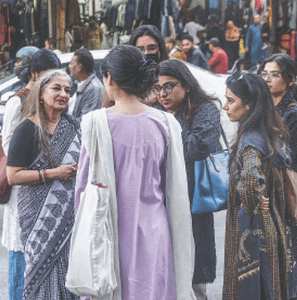THATTA: Experts at the first international conference on Makli held at the centuries-old necropolis on Saturday highlighted different aspects of the graveyard’s architecture, ways and means to preserve the heritage site and promote it as tourism destination.
They explored at the first session of the moot jointly organised by the Sindh department of culture, tourism and antiquities and the Endowment Fund Trust for the Preservation of Heritage of Sindh the question raised by moderator, Zain Mustafa, a distinguished researcher, ‘what role the Makli architecture can play in contemporary architecture’.
Rabela Junejo, assistant professor at the department of architecture and planning at the NED University of Engineering and Technology, responded by saying that the textbooks were confined to Mughal architecture and they did not make any mention of local architecture.
She read out paper on “Tomb of Eesa Tarkhan II: The place of converging architectural idioms” and said the tomb displayed a fusion of Central Asian and Indian influences with the local architecture, she said.
Dr Rafique Mughal of Boston University’s archaeological department and Pakistan Heritage Society presented his paper on “Cultural landscape of Makli based on survey of ancient settlement sites in lower Sindh” and said that natural phenomenon change of course by Indus river and earthquakes determined locations of different archaeological sites, including Makli.
Dr Mehdi Tavassoli from Iran spoke on “The anthropological study of relationship between Iran and Sindh based on most frequent themes of Makli graveyard” and informed the audience that the motif in Makli tombs was lotus which was also found in archaeological sites of Iran.
He said that remains of Moenjodaro and Shehr-i-Sokhta and other sites in Iran indicated political, commercial and cultural ties between Iran and historical Sindh.
Rand Eppich, a conservation architect, said that Makli was a ‘living site’ which made it more difficult to manage and harder to conserve.
Anthropologist Dr Zulfiqar Kalhoro read out his paper on “History, origin and development of canopy architecture in Thatta” and argued that instead of looking for outer influences experts should look for the origin of the use of canopy in ancient Sindh and even in cave paintings.
Dr Kaleemullah Lashari’s was perhaps the most interesting paper titled “Makli: An epigraphic odyssey” but he was unable to read it because of time constraints and lack of computer support. Yet it failed to deter him and he talked extempore.
He said that Makli was a miracle of written word and a museum of calligraphy rich in amazing wealth of inscriptions on graves, ranging from Quranic verses and Hadith to elegies in Persian.
He called for research on elegiac tradition prevailing in Thatta of the past.
Speaking to the audience, Chief Minister Syed Murad Ali Shah said that Makli necropolis is not just a graveyard but a heritage treasure that tells the rich history of Sindh’s glowing past stretched over thousands of years.
He said that the views of experts, archaeologists and historians expressed at this conference would be kept in record and their recommendations tabled in the provincial cabinet’s meeting.
“The Sindh government is doing its best to preserve historical and heritage sites in the province and would continue to extend its full cooperation to everyone working for the cause.
Culture Minister Syed Sardar Ali Shah, Senator Sassui Palijo, Abdul Hameed Khan Akhund and Qazi Ayaz Mahesar also addressed at the inaugural session.
Dr Rafique Mughal, Dr Mohammad Mahdi Tavassli and Mariam Tavssali read papers on different topics relating to the heritage site.
Published in Dawn, January 14th, 2018

































